If you’re considering getting a pet turtle, it’s important to understand that not all turtles remain small throughout their lives. Some species can grow quite large, which can make caring for them more challenging. Fortunately, there are several types of pet turtles that stay small and don’t require a lot of space. In this article, we’ll introduce you to 9 pet turtles that stay small and won’t outgrow their enclosures. We’ll also provide pictures of each species, so you can see their unique characteristics and decide which one is right for you.
The 9 best pet turtles that stay small and don’t grow are:
- Reeve’s turtles
- Diamondback terrapins
- Mud turtles
- Musk turtles
- Box turtles
- Spotted turtles
- Bog turtles
- Padloper tortoises
- Razorback Musk turtle
These pet turtles can make excellent companions for those who have limited space or resources. However, it’s important to note that owning a pet turtle requires a significant amount of responsibility and commitment. Proper care, feeding, and habitat maintenance are essential for keeping these animals healthy and happy. With that in mind, let’s take a closer look at these 9 pet turtles that stay small and don’t grow.
1. Reeve’s Turtles

Size: males between 4 and 5 inches, females between 6 and 8 inches.
Appearance: Reeve’s turtles are mostly plain looking but they have a few things that sets them apart from the rest of the turtles. The shell has three longitudinal keels and the color ranges from tan to olive green to black, occasionally with faint contrasting radiation or smudging. Other than the three ridges they have a very plain appearance.
Lifespan: up to 20 years.
Where they live: Reeve’s turtles are also known as Chinese pond turtles, and they are found in Eastern Asia, primarily in China, but also in Korea, Japan and Taiwan.
Pet difficulty: Medium. Reeve’s turtles are very hardy and they have a simple diet. The only drawback is that even if they are aquatic turtles, they aren’t very good swimmers, so you will have to be careful with the water levels of the tank. In general you should make sure that the water depth is one and a half the length of the turtles shell. So if you have a 4 inch turtle, the water should be 6 inches deep ( 4 x 1.5 ), if the turtle has 2 inches the water should be 3 inches deep ( 2 x 1.5 ).
2. Diamondback Terrapins

Size: males between 3 and 5 inches, females between 4 and 7 inches.
Appearance: Diamondback terrapins are divided into a lot of subspecies, and each one of them has a different appearance. In general the shell of diamondback terrapins is wider at the back than in the front, having a shape similar to a wedge if you look at them from above. The color of the shell can vary a lot, but it’s usually brown or gray and all the shades between them. The color of the body can be brown, yellow, gray or white. All diamondback terrapins subspecies have very interesting patterns on their skin, in the form of black wiggly spots. Diamondback terrapins also have large feet, compared to other turtle species.
Lifespan: up to 30 years.
Where they live: Diamondback terrapins live in the Atlantic and Gulf coasts of the United States. From the northern parts of Massachusetts to the southern parts of Florida and around the Gulf Coast to Texas.
Pet difficulty: Medium. Diamondback terrapins are very good beginner pets, they are very hardy, they have a typical turtle diet. And in general they are very easy to maintain. The only problem is that their population is not in the best shape right now and in some places it can be illegal to own one, so if you are thinking of getting a diamondback terrapin you should first check the local laws.If it’s legal to own one and you are looking for your first pet turtle than you should really consider getting a Diamondback terrapin, the can be great beginner turtles.
3. Mississippi Mud Turtles
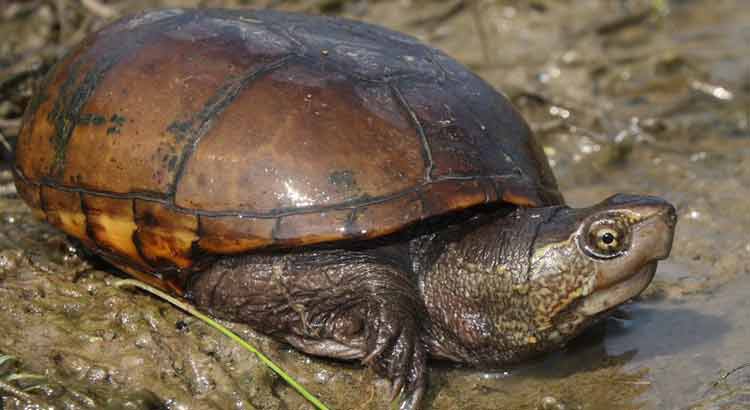
Size: between 3 – 5 inches.
Appearance: As the name implies they have a grey-brown color very similar to the color of mud, depending on the are from which they are the shades of the color can vary a little. They also have a very spherical shell compared to most turtles that have them more flattened. And of course they are very small.
Lifespan: up to 50 years.
Where they live: Mud turtles can be found in the United States, more precisely in the following states: Alabama, Arkansas, Delaware, Florida, Georgia, Illinois, Indiana, Kentucky, Louisiana, Maryland, Mississippi, Missouri, New Jersey, New York, North Carolina, Oklahoma, Pennsylvania, South Carolina, Tennessee, Texas, and Virginia.
Pet difficulty: Beginner. Mud turtles are a good first pet turtle, they are relatively easy to maintain, they don’t require any kind of special treatment. They are also very hardy and are not pretentious when it comes to food. In general a 40 gallons tank should be enough for a mud turtle. Just be careful to provide them a solid place where they can rest, mud turtles aren’t the best swimmers. So if you are looking to get your first pet turtle and you want it to be a small turtle the musk turtle is a great choice.
4. Common Musk Turtles

Size: between 3 – 4 inches.
Appearance: The color of the common musk turtles tends to be a darker gray, sometimes getting very close to black. On their heads they have a pair of irregular horizontal yellow stripes that run along the sides.
Lifespan: up to 50 years.
Where they live: There are three species of musk turtles, and each species lives in a different place. The smaller species that we are interested in can be found in southern Canada, as well as the United States and Mexico.
Pet difficulty: Beginner. Musk turtles are great turtles for a beginner, they are one of the hardiest species that you can find. Baby musk turtles are a little fragile, but after a few months that is no longer a problem. They are not pretentious when it come to temperature, and the fact that they stay small means that you won’t need to get a tank that is too big.
5. Eastern Box Turtles
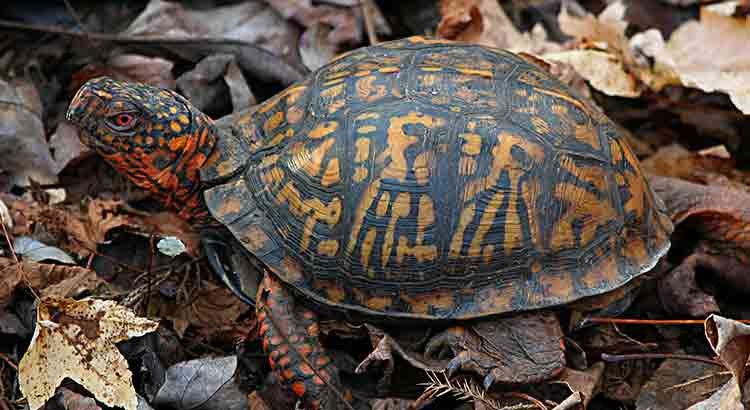
Size: between 4 and 6 inches.
Appearance: Eastern box turtles are a very colorful species. Their shell is dark-grey and it’s covered with many yellow or orange splotches. The pattern of the splotches is not something consistent and can vary from turtle to turtle. As a turtle ages the colors start to dim down becoming less and less prominent. One other interesting thing about their appearance is that males often have red eyes, giving them a very unique appearance.
Lifespan: up to 50 years.
Where they live: As the name implies, eastern box turtles can be found in the eastern parts of the United States. The northest part that eastern box turtles can be found is Maine, and the southern and eastern portions of the Michigan Upper Peninsula, south to southern Florida and west to eastern Kansas, Oklahoma, and Texas.
Pet difficulty: Medium. Eastern box turtles are not difficult as pets, but unlike most turtles on this list they enjoy spending a lot of time on land instead of water, so their tank / enclosure has to be more of a terrarium than an aquarium. In this regard they are more similar to tortoises than turtles. But other than that they are relatively easily maintainable. They are very hardy like most beginner turtles and their diet is similar to most turtles.
6. Spotted Turtles
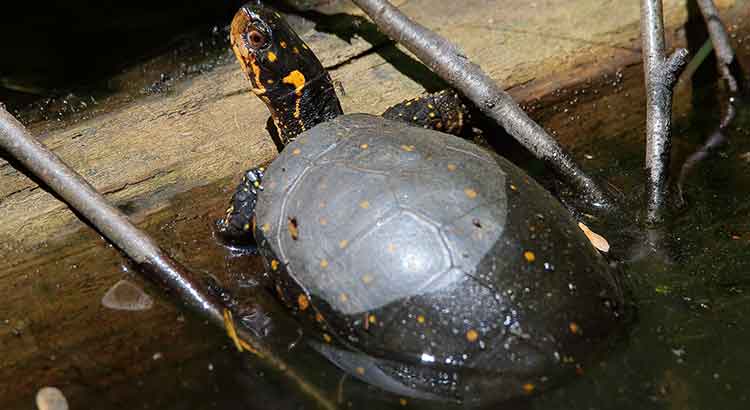
Size: between 3 and 5 inches.
Appearance: Spotted turtles have a very unique appearance among turtles. They are covered with a dark black color and they have small round spots on them that can be various shades of yellow. The spots can be distributed randomly along the shell, or they can be one per scute.
Lifespan: more than 100 years.
Where they live: Spotted turtles can be found in Canada in Quebec and Ontario, and in the United States in Maine, Florida, Indiana and Ohio.
Pet difficulty: Medium. Spotted turtles also enjoy spending a lot of time on land, so their tank / enclosure should also be half land and half water. Other than that they are relatively easily maintainable. They are very hardy like most beginner turtles and their diet is similar to most turtles. At the moment the spotted turtles are an endangered species, so keeping one as a pet can actually be bad for the species if they don’t have the chance to reproduce.
7. Bog Turtles

Size: between 3 and 4 inches.
Appearance: Bog turtles have one very distinct visual characteristic that sets them apart from the rest of the turtles out there, they orange blotches that they have on each temple. They are the only species that have such a visual feature. Other than that there is nothing special to be said about their appearance.
Lifespan: up to 50 years.
Where they live: Bog turtles only live in the eastern part of the United States, and they are split in two groups, the northern group, and the southern group. The northern group can be found in Massachusetts, Maryland, Delaware and sometimes in New York. The southern group can be seen in Tennessee, North Carolina, Virginia and Georgia.
Pet difficulty: Very difficult. Bog turtles share the same habitats as the spotted and the eastern box turtles, so naturally they will require the same conditions. You will need to provide them with a tank / enclosure that is half land and half water. Other than that they are relatively easily maintainable. They are very hardy like most beginner turtles and their diet is similar to most turtles. What makes me say that they are very difficult is the fact that at the moment their species is in a critical condition. And keeping one as a pet can be very harmful to the species. Even if it’s theoretically easy to take care of them you shouldn’t consider keeping one as a pet.
8. Speckled Padloper Tortoises (Smallest Tortoise in the World)
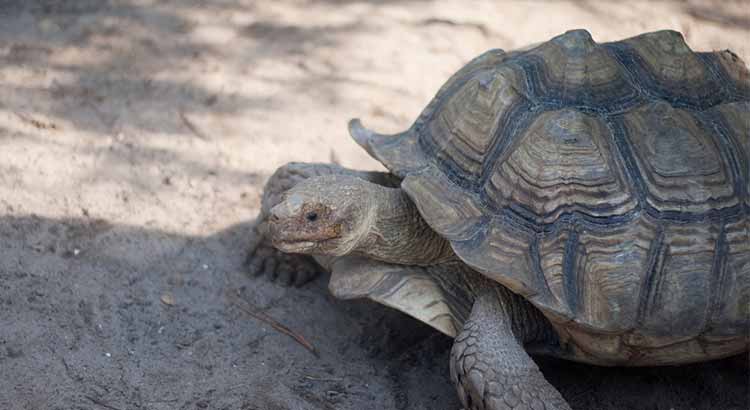
Size: between 2 and 3 inches.
Appearance: Speckled Padloper tortoises are the smallest tortoises in the world and they also have a very unique appearance. The scutes on their shells are very pronounced, often looking like a small form of pyramiding. One other interesting visual characteristic is represented by the pronounced scales that they have on their legs. The Speckled Padloper tortoises almost look like they lived in the same time as dinosaurs with their rough looking appearance.
Lifespan: up to 50 years.
Where they live: Speckled Padloper tortoises live in a relatively small and rocky area in the west of South Africa, the area is called Little Namaqualand.
Pet difficulty: Very difficult. Speckled Padloper tortoises are an endangered species and only a few zoos keep them. Keeping one as a pent can do a lot of harm to the species since they won’t be able to breed, if they are kept alone. And even if you have a male and a female, breeding for them can be very difficult in captivity. So you shouldn’t consider this tortoise as a pet.
9. Razorback Musk Turtle
Size: between 5 – 6 inches.
Appearance: Razorback Musk Turtles have a lightly colored skin that is covered with black spots, that can give them a distinct look from other turtles. But the most distinct feature are the ridges that develop on its back, hence the name Razorback.
Lifespan: 20 to 25 years
Where they live: Razorback Musk Turtles can be found in the states of Alabama, Arkansas, Louisiana, Mississippi, Oklahoma, Florida, and Texas.
Pet Difficulty: Beginner. Razorback Musk Turtles are a good first pet turtle, they are relatively easy to maintain, they don’t require any kind of special treatment. They are also very hardy and are not pretentious when it comes to food. In general, a 50 gallons tank should be enough for a razorback musk turtle.
Important note
If you are considering getting a pet turtle I strongly suggest you check out the following sections of the site. In those sections you will find guides that cover every essential bit of information that a turtle owner needs to know, and all the turtle equipment that you will need:
Why Small Turtles are Great Pets
Small turtles are great pets for a lot of reason, here are some of them:
They require less space. As a turtle grows bigger it will require a lot more space in the tank, and this can be a huge problem if you don’t have too much space to spear. But with a small turtle that doesn’t grow you won’t be facing this problem. Most of those species will only require a tank that will be 30 or 40 gallons.
You don’t have to clean after them as often. Since they are smaller they will also need longer to make the water dirty. This doesn’t mean that you won’t have to change the water at all but you will probably only have to do it once every two weeks, instead of once every week like you would have to do with a regular sized turtle. Even if it’s not that hard to change the water in the tank it can get dull and unpleasant to do it every week. But with a smaller turtle you will have to do it less often.
They don’t eat as much food. Since they are smaller they will have to eat less food than other turtles. This doesn’t man that you have to feed them less often, but instead you have to give them less food. Over time the lesser quantity of food that they eat will reflect in your budget. Even if turtle food is not very expensive, saving 10 or 20 dollars every month is always a good thing.
They are cheaper to maintain. The food isn’t the only place where you will be saving money, you will also be saving money on electricity bills since they won’t need very powerful heating lamps and UV bulbs, don’t get me wrong they still need them but the area that the lights have to cover will be smaller so they don’t have to be as powerful. And you will also save a lot of money on equipment. Most turtles that grow in size over time will need new tanks to live in and a new water pump that is able to keep up with the turtle. But for those turtles that don’t grow large you won’t have to change them at all.
They are very cute. Smaller animals are usually cute, and in my opinion some of the cutest animals in the world are small turtles. You might not be sharing my opinion here, but I think this is one big advantage small turtles have over regular sized ones.
Why You Might Not Want a Small Turtle
I’ve spent a lot of time thinking about a reason why you might not want a small turtle and I was unable to come up with one. There is no practical reason why you might not want a small turtle, they do the same things a regular sized turtle does and they even have some advantages over them.
But in the end it all comes down to personal preference, if you don’t like the idea of a small turtle than that can be a good reason why you shouldn’t get one, other than that there is no good reason.
Final Thoughts
Small turtles can be a great pet, especially for a beginner, since they don’t need as much space and food, and most of them are pretty hardy.
One final piece of advice I want to give you is to check the law in your area before you start looking for a specific turtle species. Some species are endangered, some are very close to extinction. And even if you find somebody who sells them, they might do so illegally. So please check the law before purchasing any turtle, regardless of the place you buy them.
If you think I missed something important about one of the turtle, or you think another species should be included on the list please let me know in the comment section. And if you have any questions about turtles you should also leave them in the comment section and I will answer them as soon as possible.

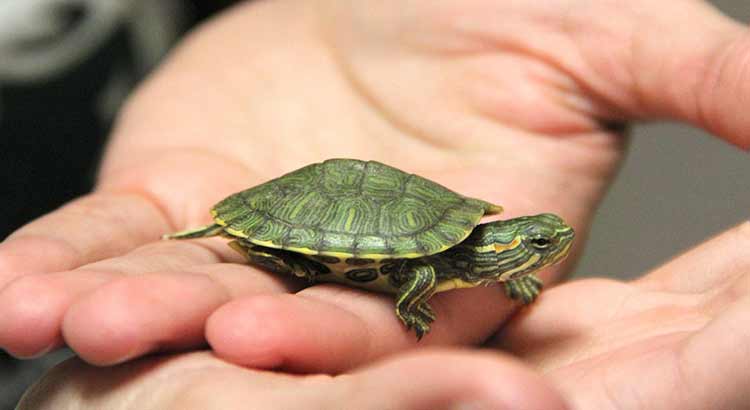
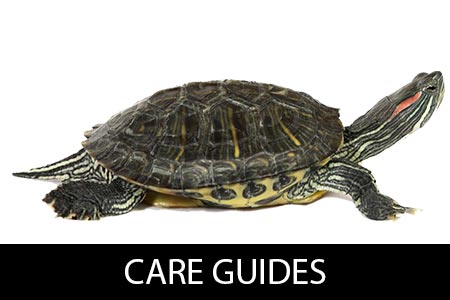
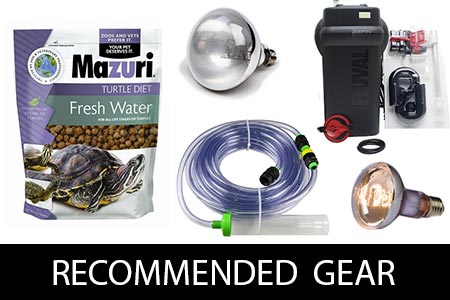

Thatk you for your post and resurch.
I really appriciate as it help me decide and understand turtles I want to buy.
Tha k you. Regrds
What is the name of the turtle at the top of this article (first picture)?
The turtle in the picture is called a Red-Eared Slider, this turtle is not featured in the list of small turtles, even if a lot of people think they are small they can reach quite impressive sizes.
I just got 2 small turtles that stay smell… I never had one before so I’m trying to get info about what to do..wanted to know how many times u feed them an how much water an can u pick them up…
Hello Brittney,
I know things can seem overwhelming at the start but don’t warry you will soon see that it’s not that complicated to take care of pet turtles. My suggestion is to check out the Care Guides section of the site and take a look at some of the basic things. And if you are interested in something specific use the search function of the website and search for the subject that you are interested in.
And if you have any question just leave a comment on any article and I will answer it as soon as possible.
Can you tell me what two small turtles you bought that don’t grow
Sure, just send a photo.